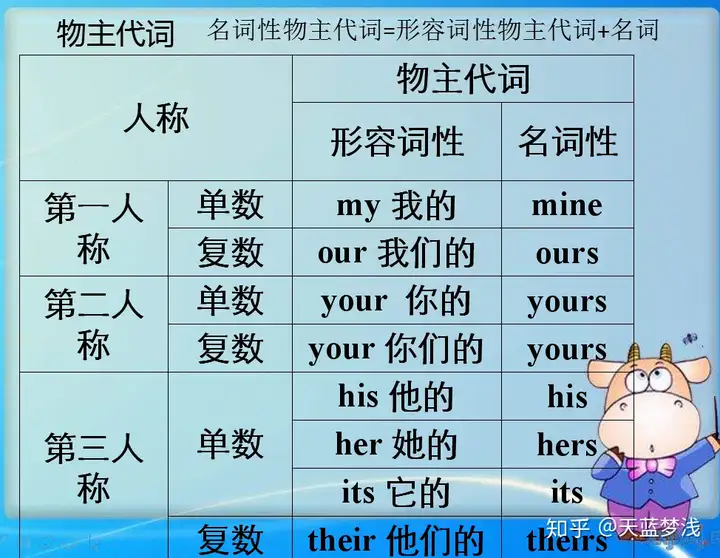
是不是感觉看过这两个句子有点晕,就是不同的单词语序颠倒一下,用的单词就完全不同了,今天和大家详细分析一下。
物主代词顾名思义指物的主人,表示所属关系。即:你的,我的,他的,她的,它的,你们的,我们的,他们的。例如:
my dog, his pen, our pencil.
形容词性物主代词有形容词的性质,可以修饰名词,而名词性物主代词具有名词的性质。不能再用来修饰名词。
名词性质的物主代词,等于形容词性的物主代词加上它所要修饰的名词。
例如:
This is my bag. = This bag is mine.
形容词性和名词性物主代词都译成 “......的”
但是名词性物主代词 =形容词性物主代词+名词。
Is that your pen? ( 形容词性物主代词 )
Yes, it is mine. ( mine= my pen ) (名词性物主代词)
具体我们看看下面几张表格

最后,我们发现了一个规律,以后只要是在做题的时候记住这个规律就可以了,结合上面的口诀,加上最后一句话就是:
名词性物主代词后面不跟名词,
形容词性物主代词后面必须跟名词。
来几道题练练手,想知道答案可以评论。
1. What is ______(she) English name?
2. _____(我) father is a doctor.
3. Where is ______(you) library?
4. _____(I) have a pet cat. _____(it)name is Joy.
5. ______(we)classroom is big.
6. ______(they) books are colorful.
7. ---Are these ________(they)bags ?
---No, they aren't ________(their). They are
____(we).
8.My bag is small. Can I use _______ (你的)?
9. That is___________(他们的) new house.
10. My ruler is long. ____________ ( 她的 ) is short.
11. __________(他的) teacher is good. ___________(她的)is good, too.
(责任编辑:admin) |